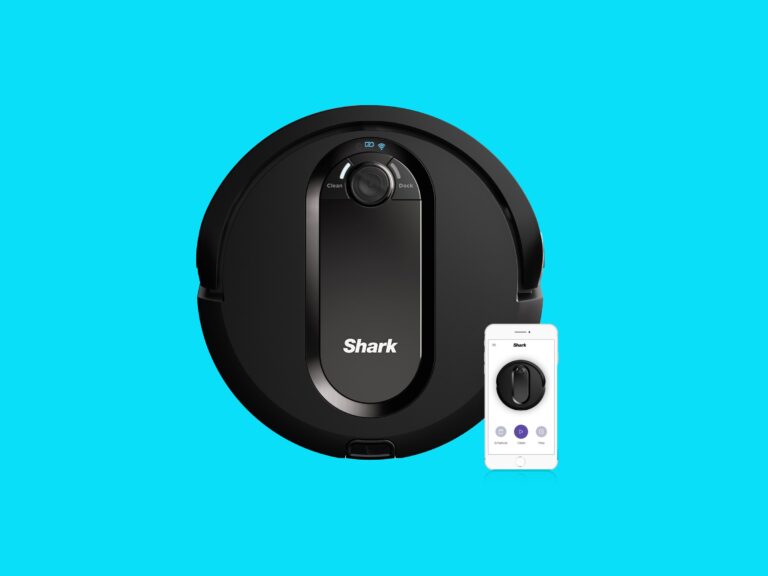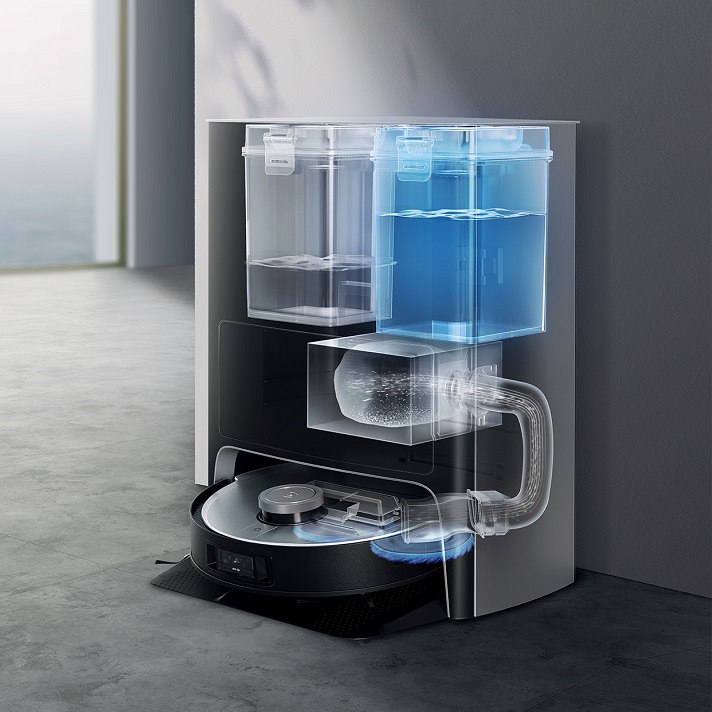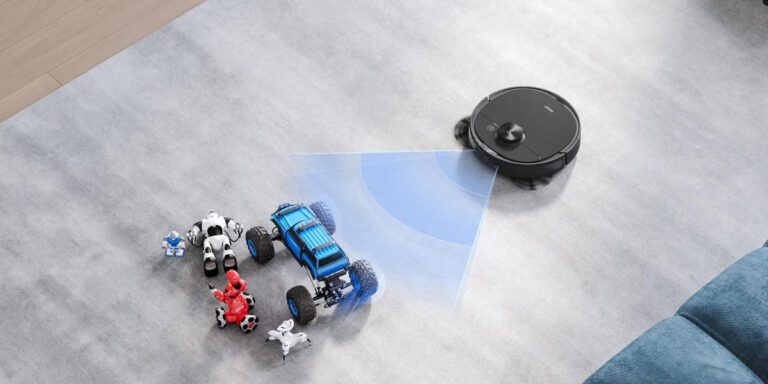Why Does My Shark Robot Vacuum Keep Stopping?
The shark robot vacuum may keep stopping due to a clogged brush roller or sensor issues. Are you frustrated with your shark robot vacuum constantly stopping mid-clean?
If so, there may be a simple explanation. One possible reason is a clogged brush roller, which can hinder the vacuum’s ability to pick up dirt and debris effectively. Another common issue is sensor problems, which can cause the vacuum to frequently pause or encounter obstacles.
It is important to address these issues promptly to ensure optimal performance and a seamless cleaning experience. We will explore the reasons why your shark robot vacuum may keep stopping and provide practical solutions to resolve these problems. Keep reading to discover how to keep your robot vacuum running smoothly and efficiently.

Credit: cleanhomies.com
Common Reasons For Shark Robot Vacuum Stopping
Are you frustrated with your shark robot vacuum constantly stopping in the middle of cleaning? You’re not alone. Many users experience this issue, which can be quite annoying, especially when you’re relying on your vacuum to keep your floors clean and tidy.
In this section, we’ll explore some common reasons why your shark robot vacuum may be stopping unexpectedly. Understanding these factors can help you troubleshoot and resolve the problem, ensuring uninterrupted vacuuming performance.
Battery Drainage: Understanding The Impact Of Low Battery Life
One of the primary reasons why your shark robot vacuum may keep stopping is battery drainage. Here are some key points to consider:
- The battery life of your robot vacuum can vary depending on the cleaning mode and the size of the area it needs to cover. Higher cleaning modes and larger areas will drain the battery faster.
- If the battery is low, the vacuum may stop to recharge itself. This process can take some time, causing interruptions in your cleaning routine.
- To prevent frequent stops due to low battery, make sure to charge your device fully before each cleaning session. Additionally, consider investing in a model with longer battery life if you have a large cleaning area.
- Regularly check the battery health and replace it if necessary. Over time, batteries may lose their capacity to hold a charge, leading to more frequent stops.
Obstacle Detection Failure: How It Affects Continuous Vacuuming
Another common reason for your shark robot vacuum to stop is obstacle detection failure. Here are some important points to be aware of:
- Robot vacuums are equipped with sensors to detect obstacles such as furniture, walls, or staircases. These sensors help the vacuum navigate around your home and avoid collisions.
- If the sensors are dirty or obstructed, the vacuum may not detect obstacles correctly, leading to frequent stops.
- Check the sensors regularly and clean them to ensure they are free from dust, hair, or debris.
- Make sure your home is adequately prepared for the robot vacuum by removing any large objects or potential hazards from the cleaning area.
Brush And Filter Maintenance: The Key To Uninterrupted Cleaning
Proper maintenance of the brushes and filters is crucial for uninterrupted cleaning performance. Consider the following points:
- Over time, the brushes and filters can get clogged with dirt, hair, and debris, affecting the suction power of the vacuum.
- Regularly clean the brushes and filters according to the manufacturer’s instructions.
- Check for any damages or wear and tear on the brushes and filters. Replace them if necessary to maintain optimal performance.
- To prevent frequent stops, clear any blockages in the brushes or filters that may hinder the vacuum’s movement.
By addressing these common issues related to battery drainage, obstacle detection failure, and brush and filter maintenance, you can improve the performance of your shark robot vacuum and minimize unexpected stops. Remember to take proactive steps to maintain your robot vacuum regularly, ensuring it operates smoothly and efficiently, leaving your floors spotless without interruptions.
Battery Drainage: Understanding The Impact Of Low Battery Life
Why Does My Shark Robot Vacuum Keep Stopping
Have you ever experienced the frustration of your shark robot vacuum constantly stopping its cleaning cycle? If so, you’re not alone. One common reason behind this issue is low battery life. Understanding the impact of low battery on your shark robot vacuum’s functionality is crucial in ensuring smooth operation.
In this section, we will delve into why a low battery causes your shark robot vacuum to stop and provide you with tips and tricks to maximize its battery life.
Why A Low Battery Causes Your Shark Robot Vacuum To Stop
- Inefficient cleaning: When the battery levels of your shark robot vacuum are low, it affects the device’s ability to navigate and cover all areas effectively. As a result, the vacuum may struggle to complete its cleaning cycle, leading to frequent stops.
- Power preservation: To prevent the vacuum from dying completely, shark robot vacuums are programmed to stop cleaning and return to their charging dock once the battery levels reach a certain threshold. This helps to preserve the battery power for the next cleaning session.
- Safety precaution: Low battery can hinder the vacuum’s ability to return to the charging dock. To prevent the vacuum from getting stranded mid-cycle, it automatically stops and awaits manual intervention once the battery is critically low.
Maximizing Battery Life: Tips And Tricks You Should Know
- Regular charging routine: Establishing a regular charging routine for your shark robot vacuum is essential for maintaining optimal battery life. Ensure that you place the vacuum on its charging dock after each cleaning session, allowing it to recharge fully before the next use.
- Avoid deep discharges: Deeply discharging the battery on a frequent basis can have a detrimental impact on its overall lifespan. Try to avoid letting the battery drain completely before recharging it. Instead, aim to recharge it when the battery level is around 20% to 40%.
- Optimize cleaning path: By ensuring that your home is clear of obstacles and clutter, you can help your shark robot vacuum navigate smoothly and minimize unnecessary battery drain caused by bumping into objects or retracing its path.
- Power-saving mode: Enable the power-saving mode on your shark robot vacuum, if available, to prolong battery life. This feature reduces the device’s suction power, allowing it to clean for longer periods without draining the battery quickly.
- Maintenance and cleaning: Dirty sensors, brush rolls, and filters can put additional strain on the battery, reducing its efficiency. Regularly clean and maintain these components to ensure optimal performance and maximize battery life.
Understanding the impact of low battery life on your shark robot vacuum’s functionality is key to resolving the issue of frequent stops during cleaning cycles. By implementing the tips and tricks mentioned above, you can not only extend the battery life of your vacuum but also enjoy uninterrupted and efficient cleaning sessions.
So, keep these suggestions in mind and let your shark robot vacuum tackle the cleaning tasks with ease and efficiency.
Obstacle Detection Failure: How It Affects Continuous Vacuuming
Why Does My Shark Robot Vacuum Keep Stopping?
If you own a shark robot vacuum, you may have experienced the frustration of it stopping unexpectedly during cleaning sessions. One common cause for this issue is obstacle detection failure. In this section, we will explore how obstacle detection systems work in shark robot vacuums, common issues that can lead to obstacle detection failure, and a troubleshooting guide to help you resolve the problem.
How Obstacle Detection Systems Work In Shark Robot Vacuums
Shark robot vacuums are equipped with advanced obstacle detection systems that allow them to navigate around your home safely and efficiently. These systems utilize a combination of sensors, cameras, and smart algorithms to detect and avoid obstacles in their path.
Here are the key points to understand about how these systems work:
- Sensor technology: Shark vacuums are equipped with various sensors, such as infrared sensors and cliff sensors, that detect obstacles and drop-offs. These sensors send signals to the vacuum’s control system, enabling it to adjust its course or stop to avoid collisions or falls.
- Camera-based vision system: Some shark robot vacuums are equipped with built-in cameras that capture real-time images and use computer vision algorithms to identify objects in their environment. This allows the vacuum to differentiate between furniture, walls, and other obstacles, making navigation more precise.
- Smart algorithms: The obstacle detection systems in shark robot vacuums rely on intelligent algorithms that analyze sensor data and camera images to make informed decisions about navigation. These algorithms take into account factors like object size, distance, and the vacuum’s current trajectory to determine the best course of action.
Common Issues That Cause Obstacle Detection Failure
While shark’s obstacle detection systems are designed to be reliable, there are certain common issues that can lead to obstacle detection failure. It’s important to be aware of these issues to troubleshoot and address them effectively. Here are some key points to note:
- Low light conditions: Obstacle detection systems may struggle in low light conditions, as the sensors and cameras rely on adequate lighting to accurately detect and identify obstacles. Ensure that your cleaning area is well-lit to prevent detection failures.
- Reflective surfaces: Highly reflective surfaces, such as mirrors or glass, can pose challenges for obstacle detection systems. The reflective nature of these surfaces may cause sensors or cameras to misinterpret the surroundings, resulting in navigational errors.
- Cluttered environment: Excessive clutter or an overly crowded environment can overwhelm the obstacle detection systems, leading to false readings or navigation issues. Clearing the area of obstacles and creating a more open space can help improve detection accuracy.
Troubleshooting Guide For Obstacle Detection
If your shark robot vacuum is experiencing obstacle detection failure, there are several troubleshooting steps you can take to resolve the issue. Here’s a brief guide to help you troubleshoot obstacle detection problems:
- Check lighting conditions: Ensure that the cleaning area is well-lit to provide optimal conditions for the vacuum’s sensors and cameras.
- Clean sensors and cameras: Dust or debris on the sensors or cameras can interfere with their functioning. Carefully clean these components with a soft cloth to remove any obstructions.
- Clear clutter: Remove any unnecessary clutter or obstacles from the cleaning area to prevent detection issues caused by a crowded environment.
- Restart and update: Try restarting the vacuum and ensuring that it has the latest firmware updates installed. Sometimes, a simple reboot or update can resolve obstacle detection problems.
- Contact customer support: If the issue persists, it’s recommended to reach out to shark’s customer support for further assistance and guidance.
By understanding how obstacle detection systems work in shark robot vacuums, being aware of common causes of failure, and following the troubleshooting guide, you’ll be better equipped to address and resolve obstacle detection issues with your vacuum. Enjoy uninterrupted cleaning sessions and a spotless home with your shark robot vacuum!
Brush And Filter Maintenance: The Key To Uninterrupted Cleaning
The Importance Of Regular Brush And Filter Cleaning
Proper maintenance of the brushes and filters in your shark robot vacuum is crucial for ensuring uninterrupted cleaning performance. Neglecting this essential step can lead to various issues like reduced suction power, clogged brushes, and even complete stoppage of the vacuum.
To avoid these problems and keep your shark robot vacuum running smoothly, it’s important to understand the importance of regular brush and filter cleaning.
Here are the key points to consider:
- Effectiveness: Over time, the brushes and filters in your shark robot vacuum can become clogged with dirt, debris, and pet hair. This accumulation can hinder their effectiveness in picking up and trapping particles. Regular cleaning ensures that the brushes and filters are free from blockages, enabling them to perform optimally.
- Efficiency: When the brushes and filters are clean, your shark robot vacuum can efficiently navigate your home and thoroughly clean different surfaces. Without proper maintenance, the vacuum may struggle to pick up debris, resulting in an incomplete cleaning job.
- Longevity: By following a regular brush and filter cleaning routine, you can extend the life of your shark robot vacuum. This preventive maintenance reduces wear and tear on the brushes and filters, preventing costly breakdowns and the need for frequent replacements.
- Hygiene: Cleaning the brushes and filters also helps maintain a hygienic environment in your home. Dust, allergens, and bacteria can accumulate in these components over time, posing a risk to your indoor air quality. Regular maintenance ensures that your shark robot vacuum continues to provide a clean and healthy living space for you and your family.
Steps To Proper Brush And Filter Maintenance
Maintaining the brushes and filters of your shark robot vacuum is a straightforward process that can be easily incorporated into your cleaning routine. Follow these steps for proper brush and filter maintenance:
- Regular inspection: Begin by inspecting the brushes and filters before each cleaning session. Look for any signs of wear or damage that may require immediate attention.
- Brush cleaning: Remove the brush roll from the vacuum and remove any tangled hair or debris using a pair of scissors or a brush cleaning tool. Ensure that the bristles are free from obstructions.
- Filter cleaning: Depending on the model of your shark robot vacuum, you may have either a foam or hepa filter. Foam filters can be rinsed with lukewarm water and mild soap, while hepa filters should be tapped gently to remove debris. Allow the filters to air dry completely before reinstalling them.
- Regular replacement: Despite regular cleaning, brushes and filters will wear out over time. Refer to your shark robot vacuum’s user manual for guidance on when and how to replace these components.
Troubleshooting Guide For Brush And Filter Issues
Even with regular maintenance, you may encounter some issues with the brushes and filters of your shark robot vacuum. Here are some common problems and troubleshooting tips:
- Reduced suction power: If you notice reduced suction power, check the brushes and filters for blockages. Clean them thoroughly and ensure proper installation before testing the vacuum again.
- Brushes not rotating: If the brush roll fails to rotate, inspect it for tangled hair or debris. Clean the brush thoroughly, making sure it spins freely before reattaching it to the vacuum.
- Filter indicator light: If your shark robot vacuum has a filter indicator light, pay attention to any warnings. This light typically illuminates when the filters need cleaning or replacement. Follow the manufacturer’s instructions to address the issue.
- Unusual noises: Strange noises coming from your shark robot vacuum may indicate a problem with the brushes or internal mechanism. Inspect the brushes for any obstructions or damage. If the issue persists, contact shark customer support for further assistance.
By adhering to a regular maintenance routine and addressing any issues promptly, you can keep your shark robot vacuum operating smoothly and efficiently, ensuring uninterrupted cleaning performance for your home.
Frequently Asked Questions On Why Does My Shark Robot Vacuum Keep Stopping
Why Does My Shark Robot Vacuum Keep Stopping?
Mostly, your shark robot vacuum may stop due to a full dustbin, tangled brush roll, or obstacles in its path.
How Can I Fix My Shark Robot Vacuum’S Frequent Stopping Issue?
To fix the frequent stopping issue, ensure the dustbin is empty, clear any tangled hair from the brush roll, and remove obstacles from the vacuum’s path.
Is There Any Way To Prevent My Shark Robot Vacuum From Stopping Frequently?
To prevent frequent stopping, empty the dustbin regularly, clean the brush roll after each use, and ensure there are no obstacles in the vacuum’s way.
What Should I Do If My Shark Robot Vacuum Still Keeps Stopping After Troubleshooting?
If troubleshooting doesn’t resolve the issue, contact shark customer support for further assistance with your robot vacuum’s frequent stopping problem.
How Often Should I Clean The Dustbin And Brush Roll Of My Shark Robot Vacuum?
To maintain optimal performance, clean the dustbin and brush roll of your shark robot vacuum after each use or at least once a week, depending on usage.
Conclusion
Understanding why your shark robot vacuum keeps stopping is crucial in order to effectively troubleshoot and resolve the issue. By examining potential causes such as tangled brushrolls, dirty sensors, low battery power, or software glitches, you can take the necessary steps to rectify the situation.
Regularly cleaning the vacuum, removing any obstructions, and ensuring the environment is free from hazards will help optimize its performance. Additionally, staying updated with the latest firmware and seeking assistance from the customer support team can be beneficial. Remember, a well-maintained shark robot vacuum can significantly contribute to a clean and efficient home.


